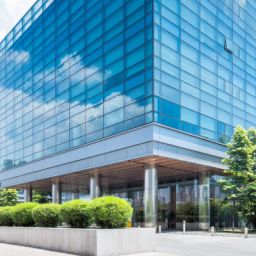
HYBRID HANGOUT
Smart Buildings, AI, and Resiliency – Insights from IFMA World Workplace: Ep 18
About the Episode
In this episode of the Hybrid Hangout podcast join FM:Systems’ Director of Product Marketing, Jennifer Heath, and Chief Strategy Officer, Brian Haines, as they dive into the latest trends and technologies shaping the future of facility management. Fresh from IFMA World Workplace, Brian shares insights on how smart building technology, AI, and digital innovations are transforming workplaces and enhancing facility resiliency.
Discover how facility managers are navigating challenges posed by extreme weather, the growing demand for energy efficiency, and the need for advanced data solutions. This episode is a must-listen for anyone in facility management, commercial real estate, or operations who wants to stay ahead in the evolving landscape of smart, sustainable buildings.
Watch the Episode
Episode Transcription
Jennifer Heath 0:14
Hello everyone, and welcome to another episode of the Hybrid Hangout podcast. I am Jennifer Heath, Director of Product Marketing here at FM:Systems,
Brian Haines 0:25
And I am Brian Haines, the Chief Strategy Officer at FM:Systems
Jennifer Heath 0:30
And we are so pleased that you’ve joined us today. We have a few different topics that we’re going to talk through today, starting with Brian’s latest travel adventure. He has been out in the world at the IFMA World Workplace trade show, which is always one of the big highlights of the year for us. So Brian, tell us a little bit about where you were and how it went.
Brian Haines 0:53
Yeah, Jennifer, it’s always a good time at World Workplace. It’s FM:Systems’ biggest event of the year. You know, we have a big booth. We’re sponsors. We work with the workplace evolutionaries group at IFMA, we work with the IT Council. There’s a number of different things that we’re involved in. So to us, it’s not just a trade show where we show our products, but it’s also an event where we participate quite a bit in thought leadership, in providing presentations, meetings with industry councils, etc. So it’s really, really quite a full impact week. And this week or last week, it was in San Antonio. That’s the second time in the past 12 years since I’ve been with FM:Systems. As a matter of fact, this week is my 12th anniversary for being with FMS, so that’s kind of fun. So it’s the second time I’ve been in San Antonio, and both times were disrupted by our hurricane, which is, you know, not a good batting average. The first time was Hurricane Sandy, which was really a catastrophe for the entire east coast, and it pretty much wiped out about half the attendance to the show. This time with the hurricane, the unfortunate hurricane that just swept across Florida, I think there were maybe a handful, small handful of people from Florida there. There was a noticeable sort of downtick, I think in the attendance, it didn’t seem to have the number of people that we had last year in Denver, and I attribute that primarily due to travel difficulties. Nonetheless, it was a good show. I think they had about 4,000 people, which is a good number, and we had a lot of great conversations.
Jennifer Heath 2:48
Nice! And so I know that you were one of the speakers. I believe Julius from Johnson Controls was also one of the speakers there. What were some of the topics that you two covered?
Brian Haines 2:58
Really, it’s all about smart buildings and data and how we can use smart building technology, and ultimately autonomous building technology, to really improve how we own and operate our facilities talent into the future. And it’s really interesting. Jennifer, one of the trends that I’ve been noticing at World Workplace, and this is not going to be a surprise. It’s becoming more digital. The number of technologies that are there, the number of sensor companies, or the number of software companies, like FM:Systems, all of our competition, everybody is there. It’s becoming very digital. It used to be when you went to World Workplace, you know, more than a decade ago, it was kind of a very broad facilities management conference, you know, lots of furniture vendors, lots of service providers, lots of people providing waste management services and they’re still there, or it just seems to be a bigger momentum towards digital and I think that’s just a reflection of where the industry is going and where our industry is going. We’re really turning to digital technologies to optimize our buildings into the future. And I said this during my presentation about smart buildings, I said, I’m going to mention AI, and I’m going to talk about AI a little bit. And who in this room has not heard about AI like 100 times this week, and everybody laughed, because it’s like, every other conversation or every other presentation is someone talking about artificial intelligence. So it’s interesting. It’s a little bit like hybrid workplace, one of those terms that I’m just getting a little bit tired of. It’s just the way we work now. It’s hybrid. That’s good enough for me. And I think AI is going to continue to be a hot topic. But, you know, I think people are maybe a little bit tired of hearing the acronym, so it’s interesting.
Jennifer Heath 5:05
Yeah, I can definitely understand that AI has become really this ubiquitous term. I mean, everything from, you know, meal planning to facility management, there’s an AI tool that can help you do that. So but it is interesting that there is this growing trend. And I remember we talked about that last year as well, that the volume of sensor companies and sensor vendors that are coming to these shows, because there is so much opportunity to get so much smarter in more managing our buildings and AI, can definitely be a part of that. But I think that it can kind of become overwhelming, and we’re maybe sort of glossing over some of the other real, concrete things that facility managers can be latching onto and implementing and leveraging that AI as a supplement to their teams and their technologies, but not looking to it to be the end all be all solution. I don’t think that that’s probably really the right way to be thinking about it.
Brian Haines 6:07
Yeah, you know, it’s interesting, because obviously the sensors are everywhere, and the technology is getting really good across the board, to solve a lot of problems. And smart buildings is not just the purview of, you know, new construction anymore. You can use them to renovate, retrofit existing buildings. You know, we’ve got clients who have buildings are that are hundreds of years old, and some in the UK that are probably 1,000 years old, putting smart building technologies in place to help them. And it’s not just about utilization anymore. If I go back when I first started seeing utilization technologies, probably maybe about 10 years ago, we had partnered with some and then we did the Asure acquisition right at the beginning of 2020, and we, you know, we ended up having our own sensor. You know, sensors back then really had a lot of challenges around things like connectivity and battery life. And, you know, they had very specific use cases. Now the technologies have evolved to where, you know, I think utilization is solved. Frankly, I think it’s solved. There’s a there’s a lot of good companies on the market. We’ve got solutions that do it really, at the world class level, to be able to understand how people are interacting with their physical environment. I think where it’s going now is how we apply utilization to all other facilities operations, and I think that’s where we’re going to start really seeing some very interesting use cases.
Jennifer Heath 7:41
I think the other thing that is really interesting about AI, and how do you, you know, incorporate this, and how do we take advantage of it? At the end of the day, AI and machine learning, it’s only as smart as the data that is fueling those models. And so for any facility manager or any operational manager that’s wondering, how am I going to incorporate this? The real question you need to be asking is, what data is going to power this? What technology is going to give me that data? And then I think the AI, and, you know, the applications of it come a little bit later, but you have to start at that level of what is the right technology to solve the problem at hand?
Brian Haines 8:23
Yeah, exactly. And it’s identifying what those problems are that you’re trying to solve, and figuring out whether or not you have the data to solve the problem. So a lot of the things that I recommend at the beginning of this process is to, one figure out what you’re trying to solve, and the second step is, you know, auditing what you have. Do you have late data sets? Do you have what you need? Do you need to supplement it with other technology or other data? And what I think is really unique about our industry is that there have been organizations using solutions like, you know, IWMS, integrated workplace management solutions, CMMS for managing computerized maintenance, enterprise asset management. There, there are these incredibly large data sets that the market has, that our clients have, that organizations have, that have been closely curated for decades. You know, they’re using it to track work order process. They’re using it to track space and occupancy management, capital projects, enterprise asset management, all of these things. And it’s almost like they’ve been sitting there waiting for AI, you know. It’s like they were there and they were and they were allowing the market to do things like, you know, create dashboards and reports that allowed them, you know, to allow analysts and you know, sort of senior real estate and facilities people to get information back. But that often took a lot of brain power and time, especially the time that a lot of facilities management teams don’t necessarily have. AI, to me, is like a gift. It’s allowing us to take these large, curated data sets and ask the most incredible questions, really complex questions, and get insights instantly to help you run things better. And then after that, it’s the smart building thing and the autonomous building thing. But right now you can, you know, with our solutions like FMS:Insights, you can simply ask a question and get an answer. It’s incredible.
Jennifer Heath 10:28
So another aspect that I want to go back to your point about the hurricane and how that has impacted the attendance and it slowed down travel. But there is kind of a broader question related to these extreme weather events, and that is how facility managers are preparing for those and responding to those. And it’s interesting that you brought it up because I was just reading an article this morning talking about the importance of building automation systems and cloud based asset management facility maintenance to prepare for those events, but also to be able to monitor and respond in the wake of those events. Was that a topic at World Workplace?
Brian Haines 11:11
Yeah, it’s interesting. There were sort of two big topics that were coming in, and one I’ve been seeing for the for the past several months, and that is around extending the life of our assets, whether it be the building or the equipment within the building, and doing things like better condition assessment. There’s a lot of advances in the way that we’re applying AI to optimize maintenance processes, which is pretty exciting, and connecting building control systems in a way that’s unprecedented, so we can actually control our environment, or have, you know, things like AI and programming control the environment better. So that’s sort of one big thing that I that I heard a lot about, and the other one was simply being able to respond more quickly to incidents such as hurricanes and this happens to our profession in a number of different ways. Things like hybrid workplace environment, social distancing, and all of that kind of stuff. Nobody was talking about that before the pandemic. Indoor air quality kind of came out of the pandemic a little bit. But where it really gained momentum was around wildfires, in particular Canadian wildfires and stuff and smoke coming down through North America, and people suddenly being a little bit more- because you could see it, right- more conscious of indoor air quality. With these catastrophic events that have been happening, and they seem to be happening more frequently. People are looking at the resiliency of their facilities. And there’s a number of different ways to look at that, right? There’s, you know, what’s the current condition of our facilities, and what are we going to do if something happens? Now, this is something that facility managers have been doing for a long time, really looking at, you know, how we’re going to respond to significant events, but I think it’s becoming more and more frequent in the conversations, and they’re looking at technology that can help them actually respond more quickly and better. There’s things like AI now is incorporating weather into things like how we think about our facilities portfolio, and getting more really accurate information about how the weather might impact our facilities and operations. The second component is, and the most important component of all of this is, is the preservation of human life and safety. We had a lot of questions, and as a matter of fact, I had a conversation this morning with someone who’s really looking at using their sensor install now and thinking about expanding it, because it’s going to help them better understand how many people are in a building and where those people are, so they can get them out, so they can communicate to them better, so they can locate them in the event of, you know, some sort of unfortunate event. And this is really, really important, and it’s something that sensors can do. They never go to sleep. They’re waiting all the time for something like this to happen. And they can provide data and availability, and that always comes on the back of like so what if my building is damaged? I’ve lost power resiliency, right? Thinking about things like backup power, those things are really, really an alternative energy sources really coming into the equation. Jennifer, as people talk to us, the conversations are getting bigger. Every time I go to a place like World Workplace, the conversations get bigger and they get more broad, and they really focus in on how this massive amount of information through real time feedback from things like sensors and building control systems and smart buildings can help us just simply do a better job across the board. So it’s fascinating.
Jennifer Heath 14:51
It is really interesting. The role of the facility manager has expanded so much in recent years. It really started largely with the pandemic. They were suddenly so front and center and how they were going to create safe spaces for employees, and now they’re in these positions where they’re needing to have business continuity plans and think about backup servers and where your data is going to live. In the article I was reading this morning, it talked about how, particularly in the wake of Helene, that there was so much damage to roads and bridges that they can’t get in to their buildings to assess. They can’t physically get on site. But if there is some level of power and connectivity, they can still remote into those building automation systems and see they can still manage the temperature, they can still manage some of those, you know, critical response elements. And so it is, it’s fascinating, when you think about facility managers, and we’ve talked about this several times, in a more historical way, you think of it as a very hands on job with a tool belt. And it’s, you know, it’s very mechanical. But today, back to your original point about the expanse of digital and technology, the facility manager role has really moved into a much more technological place, and I think it’s, I’m sure, a little bit overwhelming for folks that have been in the business for a long time. It’s a big seat change, but it creates so many opportunities for us to react in these emergency situations and to have better continuity plans and better response plans. So I think it’s a difficult time in a lot of ways, but it’s really exciting as well.
Brian Haines 16:34
Yeah, it’s interesting. It’s almost, you’ve heard me say this before, where our buildings become less of a problem and more of a partner. I really see, and I’m wondering, I’d like to talk to some people about this, if they’re using technologies like this. And of course, our buildings that are highly connected and are connected to the cloud, they may even be using, you know, advanced technologies to connect, like satellite technologies and things like that. Will building start telling us real time how they’re doing? And, you know, we could ask them how they’re doing, but will they just simply tell us how they’re doing? And I think that that’s really where the autonomous building sort of world really starts to come in. It’s not just about buildings turning lights on and off, but it’s buildings, you know, reporting their real time health. I’ve got a former colleague, who works for a sensor company that does sensors that detect water, right? Like, what if you could, you know, send that up to the cloud. And I’m sure those technologies are being deployed. But when you get that total picture of how a facility is doing, even when it’s inaccessible, you know who’s in there, you could be certain that people have gotten out. You can find out where water penetration is. You can find out where you’re experiencing problems. I mean, it’s just incredible what’s happening right now, and it’s all like these little remote people. They’re not people, they’re sensors or technologies that are just there all the time, right? They’re never, taking time off. They tirelessly work for you, I love that.
Jennifer Heath 18:04
Now, another headline that I was very excited to see, it came out on Friday, is about us and our most recent integration, Johnson Controls and their net-zero advisor platform is being integrated into FMS:Insights, which is our workplace analytics platform. And for those of you who are not already familiar, we have added the capability to compare energy usage data with your actual utilization data. So you can start to identify areas of low performance, you can start to identify areas where potentially you can cut some costs, but it also creates the opportunities for our clients to deploy the net zero advisor component as well, which opens up a whole set of doors for better energy management, advancing your sustainability goals. So I was very excited to see that headline. Talk a little bit about what you’re excited about on that front.
Brian Haines 19:06
Well, first of all, at World Workplace, any time we showed it, people were really excited. It’s an interesting thing that I had not thought about, but it’s really bridging facilities and operations between those two things. So we had facility managers from some of our clients kind of pulling in different people from their organization to see it. And once again, it’s just the broadening of that conversation, and you can reduce some really interesting things. You could see how utilization affects energy, and then look for opportunities to respond. And as you could probably imagine, Jennifer, well, you would think that buildings use a lot more energy when people are there, and that the truth is that’s the case, but they’re also using a massive amount of energy when people aren’t there, and that, to me, is kind of the golden nugget of where we’re going to be able to really increase our sustainability, reduce our emissions and our carbon footprint massively. We just simply turned off things. I mean, we’ve been told that our whole lives right by parents like when you leave the room, turn the lights off right. And buildings are taking more and more of that responsibility to do those kinds of operations autonomously. It just makes sense, right condition the room, bring it up when we know people are going to be there, when no one’s there, bring it down. There was a whole conversation because I was on a panel about a law, a sustainability law in New York City, which is really coming into play, called Local Law 97. And there’s a lot of conversation about whether or not real estate and lease agreements will change, because when someone’s leasing a space, they assume that they have access to that space seven days a week, 365 days a year. Well, building owners are saying, hold on. It’s really, really expensive for us to keep these buildings on when no one’s there. And you know, the clients are coming back who are leasing saying, whoa, whoa, hold on. Brian and Jennifer come in on Saturdays, and they work sometimes, and so we have to keep the whole building on and that, you know, that may or may not make sense. So it’s even causing a change in the way we’re thinking about things like leases, which was kind of a fascinating conversation. I never thought about that, like, will we start to see clauses where the owner of the building says, yeah, you’re leasing this building between these hours on these days, but outside of that, we’re turning them off, you know.
Jennifer Heath 21:52
Yeah, that is really interesting that there’s a sense of, entitlement is kind of a strong word, but if, you know, if you are leasing a space, you feel like you should be entitled to use that at any time. But we’re at a place in society, culturally, environmentally, where we have to start making some compromises that we can’t have everything on all the time. It’s wasteful. Commercial real estate, corporate real estate, is responsible for what, like 45% of all carbon emissions. It’s, I mean, a significant portion. And I feel like it’s one of those things that you can make, if every owner, every organization, made small changes, there would be a massive cascade of benefit. It’s one of those things that’s going to, what’s the word I’m looking for? It’s like, compound interest, right? Like every little change adds up to a significantly bigger impact. So I think that’s an interesting callout.
Brian Haines 22:49
Yeah, yeah, an interesting learning there.
Jennifer Heath 22:53
So from World Workplace, what was the highlight for you?
Brian Haines 22:59
I think probably, well, one of the highlights that I love every time is that I’ve been there many times, and when I go there, it’s like a reunion with so many people that I’ve either worked with in the past, or a lot of the people that we work with, clients, industry experts, people that I’ve sat on panels with. World Workplace is very, very different in that way. For me, it’s a place that where you go, where you’re looking forward to seeing a lot of people that you know. A lot of other shows that we participate in, where we’re, you know, which may not be driven from an industry association. You’re just kind of showing up and working and those sort of the camaraderie is not necessarily there. So that’s something that I love every year about this. But it also, just because of the broadening depth of or the broadening conversations, and the depth of the conversations around digital and the way we can solve bigger problems. This year, Jennifer, we were, and probably a lot of this was driven by Johnson Controls itself and the way we’re now part of their portfolio of companies. I was talking to airports. I was talking to people who run sports facilities. The types of facilities that we’re talking to now has really broadened. These were not in sort of the ideal customer profile of FM:Systems in the past, because we were really focused on certain areas. But that’s changed significantly, and now we’re talking to organizations that have the biggest, most physically complex plants inside of their facilities, and they want to operate them more effectively. They want to know how they’re used. They want to know everything that we’re providing already. So I love that, because I’m talking to new types of people, people that we have solutions that we can help solve.
Jennifer Heath 24:53
Definitely. It lets us think about our solutions in different ways, which, of course, for our own creativity and innovation.
Brian Haines 25:01
Yeah, my brain is just kind of exploding with all the different ideas about how we can talk in bigger ways and broader ways to new kinds of people. It’s fun.
Jennifer Heath 25:11
Wonderful, good stuff, all right. I think that is all the time we have for today. Brian, it’s always a pleasure. Glad you made it home safe from San Antonio.
Brian Haines 25:22
I did and it was a terrific time. Thank you, Jennifer, it’s always a pleasure.
Jennifer Heath 25:25
All right. Thanks everybody. Have a great day.
Brian Haines 25:27
Goodbye.














